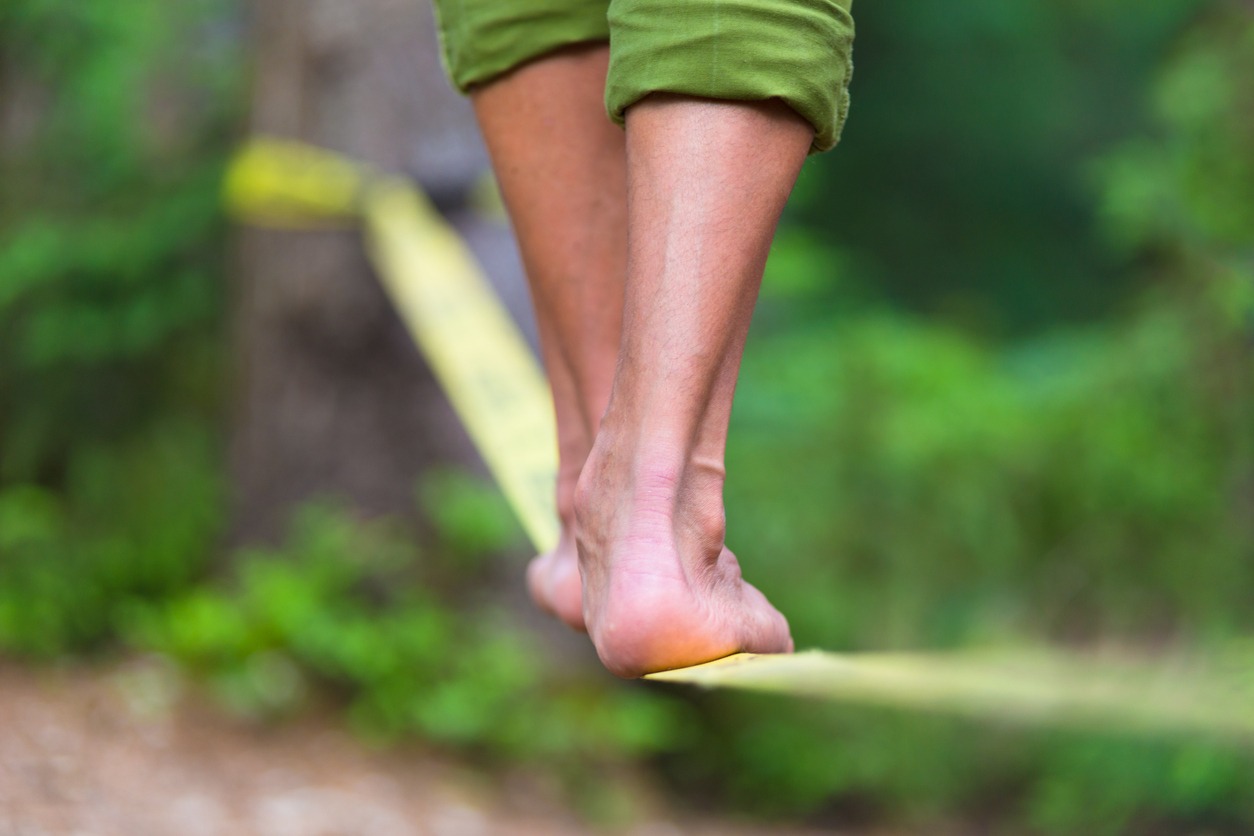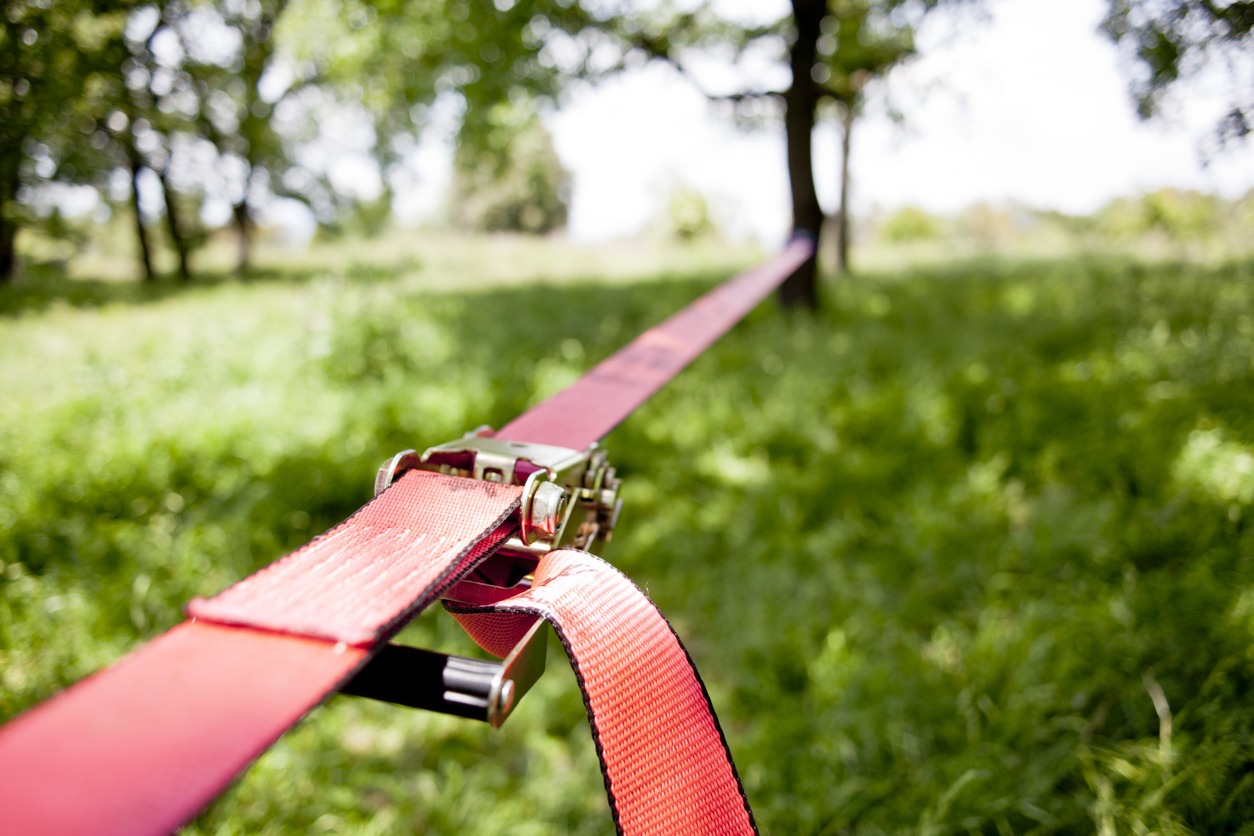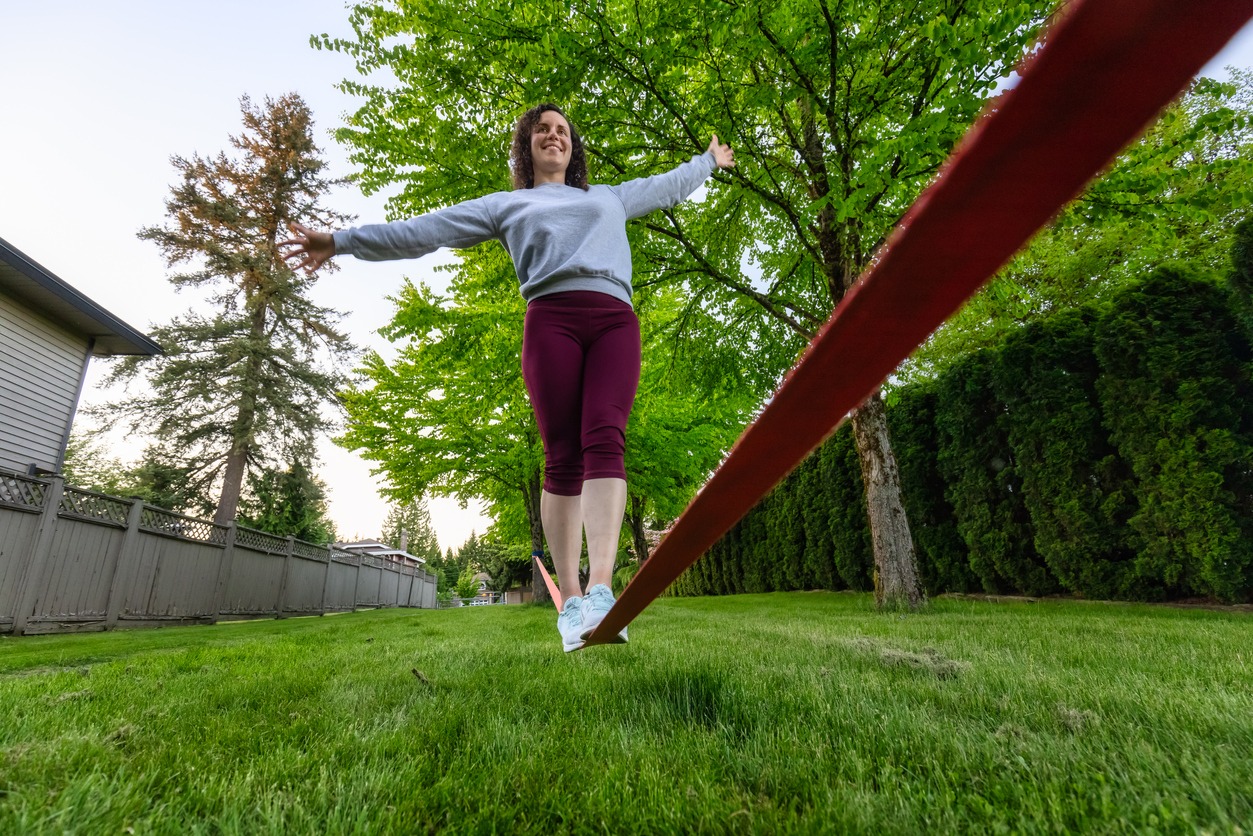Slacklining is a sport in which you walk on a thin piece of webbing made of synthetic fibers that is stretched between two fixed points, usually two trees. Slacklining is its own sport, with many different styles and disciplines, championships, and even people who do it for a living.
Slacklines are also used in competitive sports, for fitness, and in physiotherapy to help people improve their balance. The activity is also creative, with a long history of performances and shows, and it can be used to make public spaces more interesting. Slacklining is also becoming more popular in school sports, tourism, and as a way for people to spend their free time. This is partly because of slackline parks.
A slackline set is made up of a piece of webbing (not a rope), two tree slings, and a tensioning system. If the slackline is going to be set up between two trees, the set should also include tree protectors.
How to determine the slackline’s width
It might seem simpler to walk on a wider slackline. This is untrue, though. A wider slackline does nothing to support your balance; it simply tilts more. On the other hand, if you walk on a 5 cm wide slackline, you will only develop bad foot placement (the foot should always be placed straight on the line!), as you won’t be able to feel the edge of the line.
By the way, 25mm is the typical highlining width. The purpose of using such narrow lines isn’t to wow onlookers by balancing on something small. But merely because it is the width that is easiest to walk on while still providing a comfortable support surface for the foot. Having said that, we advise beginners to use a width of 25–37mm.
A 25mm wide line is preferred if you want to highline or walk longer lines (30m+).
A width of between 30mm and 50mm will feel more comfortable for tricklining and jumping than a narrow slackline.
How to determine the slackline’s length
You should be aware that a slackline with a length of, say, 30 meters can be rigged on any length up to 30 meters when choosing your slackline.
If you pick a slackline that is too short, you won’t have as many options for locations to practice walking and will find it difficult to move forward. Longer slacklines, on the other hand, require more work to coil and pack and are heavier and bulkier to carry around. Of course, the cost to purchase is also higher.
Having said that, it is advisable slackline beginners to start with a length of about 15m. Go for 30m if you’re ambitious and athletic. Beginners should only send longer lines if their preferred location doesn’t allow anything shorter.
The same is true for strong to intermediate slackliners: Except when you are certain that you need a certain length to rig your spot, avoid purchasing extremely long webbings. Owning a 200m piece just to repeatedly rig a 50m doesn’t make sense. Longer slacklines now frequently have sewn loops so you can connect multiple slacklines together. By joining two webbings, you can still increase your length with this.
How to pick a material for webbing
Nylon and polyester are the two primary materials used to make slackline webbings. Polyester is 3–4 times less stretchy than nylon. Nylon feels more flowy to walk on while polyester is easier to rig. However, the initial steps with nylon also feel more difficult for a beginner. Here is some more information:
- Polyester makes up the majority of ratchet slacklines. This material enables the use of two ratchets to rig a slackline up to 50 meters. Although using two ratchets to tension your line limits you to about 20 or 25 meters of length, using nylon and ratchets is still an option.
- Choose nylon if you enjoy flowing movements and don’t mind falling a lot as a beginner. Although this option is uncommon for beginners, it will give you longer-term enjoyment and a better flow. However, compared to polyester lines, you’ll also need to fix your lines a little higher.
- If you want to tension long slacklines in a park, polyester is obviously better because it takes much less work to do so. • If you want to learn highlining, you should definitely learn to walk on nylon. For highlines under 50 meters in length, nylon is clearly the only viable option because it will be much softer when the leash falls. Your body and the peak forces in the slackline will be affected by leash falling much more severely on a polyester highline. Before rigging your own highlines, be sure to enroll in a highline course or work with experienced individuals.
- Polyester is typically a good choice if you want to trickline. Almost no one tricklines on nylon. While jumping a nylon trickline feels incredibly fluid, it also holds more energy than other materials, making mistakes more risky.
In addition to polyester and nylon, there are some other more pricey high-tech materials. These have a very low stretch and a much higher breaking strength. They should only be used by those with a lot of experience because they are ideal for extremely long lines.
Base points
- Before installing the anchor lines, protect the anchor points (trees or fixed-purpose slackline posts) with padding, blankets, carpet, or pre-made protection devices.
- Posts, beams, etc. should be padded, rounded, or otherwise protected where anchor points are low enough that the slackline user could fall onto the top of the anchor point to help prevent injury to the user.
- The diameter of anchor points should be at least 10 to 12 inches.
- In order to hang any anchor line, anchor points cannot be damaged, such as by being cut, screwed, or nailed into, etc.
- The correct height (allowance) for installing slacklines should be clearly marked on fixed-purpose slackline anchor posts. It is improper to mark trees.
- It is forbidden to climb anchor points in order to install anchor lines higher up.
- Unless specifically designed and engineered for this use, signs, signposts, fencing, light poles, other playground equipment, park, roadway, or building structures should not be used as slackline anchor points.
Installation of a slackline
- Ratcheting systems, anchor lines, and slacklines should only be manufactured commercially.
- Slacklines shouldn’t be set up more than 24″ above a level surface of the ground.
- The surface of the ground beneath slacklines should be soft, like a thick layer of sand. The Consumer Product Safety Commission (CPSC) playground equipment surfacing recommendations are advised for all parks where slackline anchors are installed for specific slackline use.
- Slacklines should not exceed 80 feet in length.
- Installation of slacklines shouldn’t last longer than two hours at a time.
- Slacklines should never be abandoned.
- Slacklines must not block any pedestrian, bicycle, or footpath access. Additionally, slacklines shouldn’t be erected in parking lots or less than 10 feet from a road.
How Do I Begin Slacklining?
Have you ever tried to step on a slackline but it began to shake violently? Don’t panic; this is entirely normal. In addition to perseverance, it’s crucial to focus on the following crucial elements:
- Keep your attention fixed on a single, stationary point that is located in front of you. Minimizing our reliance on visual cues while walking along the webbing teaches us how to maintain balance and improves our awareness of our entire body. You can improve your body posture, focus, and spatial awareness by keeping your eyes straight in front of you.
- Place your feet along the webbing horizontally (and not under an angle). To find balance, hold your arms in the shape of a letter U above your shoulders and gently move them perpendicular to the webbing.
- To engage the legs, slightly bend your knees. To tense your torso and completely relax your arms.
- Pay attention to how you shift your weight. Only after you have properly positioned your front leg on the webbing should you shift the weight to it. Don’t hurry!
- Maintain calm and even breathing by paying attention to it. Your body will be less likely to become stiff as a result. Additionally, breathing helps to calm a mind that is too active and wanders.
- Allow someone to hold your hand as you take your first steps on a slackline in order to help you find your balance and avoid falling (holding out one finger is enough). Someone sitting in the middle of the slackline and supporting it with their feet can also make it easier.
- Starting in the default position, with one foot on the webbing and the other used for balance, is the simplest.
- Beginners should begin practicing on a slackline that is mounted close to the ground and pulled tight (20cm above the ground). The line should be 3 to 6 meters long.
- You can gradually raise the slackline above the ground as you advance and add more slack to it.
Walking on the webbing causes a constant shaking and wave-like motion that is one of its inherent characteristics. Finding the right balance between exercising conscious, logical control and giving in to feelings and intuition, or, in other words, unconscious reactions, is essential if we want to walk on a slackline. It is obvious that the latter signals reach our brain faster and, as a result, have a greater impact on our balance.
By practicing, we can access our unconscious and begin to learn about our new potentials and abilities. We can develop a variety of other useful skills by practicing balance, which is also where our creativity comes from.
Conclusion
Today, the sport has grown into many different kinds, like urban-lining, water-lining, trick-lining, freestyle, and even yoga. Each variation uses the same basic gear, but the way it’s done is different. The way the line responds to the user’s movement also depends a lot on how it is set up. For example, the precision needed for trickling is helped by a tighter ratchet. On the other hand, rigging that is looser makes it easier to swing and surf.
Even though each style is different, all of them require the mind and body to be in balance, focused, and creative. Funambulism is an ancient art of balancing that was once only done by daredevils in circuses and royal courts. But since the slackline was invented, anyone can try it. All you need are two stable points to hold the line between and the desire to play. From there, you can be as creative and athletic as you want.



